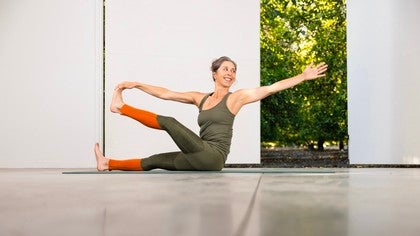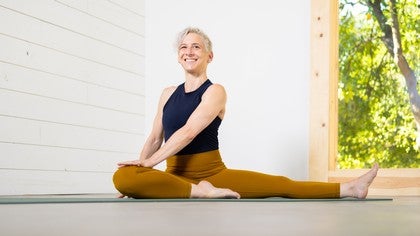
The Principles of Alignment: A Path to Healing
Yoga offers a remarkable path to healing and transformation. Through this practice deep changes such as pain relief, physical and emotional healing, and personal growth are possible and have profound, lasting impact on our health and well-being. However, the mechanics and instructions on how to reliably elicit these changes are not well known or talked about in everyday yoga classes. How do these postures and positions evoke such an inner transformation? To help you understand this process and bring this power into your practice we will take a deep dive into what I call the Alignment Principles.
Alignment is commonly misunderstood as being a rigid method of making all bodies conform to a specific image of a pose. In reality, the art of alignment is about learning to feel progressively deeper within and to create balance and space in every part of the body. The Alignment Principles provide a step-by-step framework to build this awareness so that we can “see” within ourselves, understand root causes of pain and personal challenges, and connect our total body and mind.
The magic of Asana practice is its ability to create a reflective, mirror-like experience that brings light and awareness to every corner of our being. Each unique movement, shape, and placement of the limbs and spine provides an opportunity for exploration. In order to receive accurate feedback from the body, it is essential that we have a structural point of reference, an alignment, that tells us what we should expect to see and feel. Without an alignment framework we have no way of discerning if what we’re feeling is correct or incorrect, healthy or harmful.
Let’s take a look at the five basic Alignment Principles and see how they enlighten the building of a yoga pose. The principles are listed in an order that is representative of how the body tends to learn. As one principle becomes embodied, the experiences of the next principle begin to emerge.
Alignment Principle #1: Structure
The first step of alignment is learning to engage the appropriate muscles to enter, hold, and exit a pose. This is commonly seen when we engage the quadriceps in a forward bend, the triceps in arms overhead poses, or the spinal muscles in back bends. This principle helps the nervous system intentionally feel, move, and work the muscle system.
Alignment Principle #2: Resistance
The next stage is creating balanced muscular resistance on all sides of the limbs. By hugging muscles to the bone, this principle brings our awareness to the entire limb so we can sense and correct any tendency to overextend a joint or overstretch a muscle. In Triangle pose, there is a tendency to hyperextend the knees. Using Principle #2 we learn to go beyond the initial quadricep action and engage the calf muscle and deep muscles of the foot to provide support behind the knee. This principle teaches the nervous system to sense excessive action and balances the primary working muscles.
Alignment Principle #3: Lines of Awareness
In this stage, the combination of muscular action with proper resistance throughout the limb creates lines of awareness. Because we have developed our ability to feel all the muscles of the limb we can begin to “connect the dots” and sense the limb as a line of awareness. We can feel each side of the limb for improper torques, length imbalances, overstretching, bowing, etc. In Triangle pose, the length of the front leg from inner groin to ankle is often shorter than the outside of the leg from hip bone to outer ankle. Sensing this, we can adjust the limb to create balanced lengths and thereby create a proper stretch on the groin muscles while protecting the outer hip from strain. This principle expands awareness to flow evenly along the length of the limbs and torso.
Alignment Principle #4: Content and Container
"Container" refers to the skin of the body. "Content" refers to all the layers of anatomy contained within. In this stage of development our awareness begins to penetrate from the periphery of the body to the inner contents of the limbs. We begin to sense where our organs are and how they are being affected by the pose. Through this principle, we learn to create a congruous space between all layers of tissues from skin to bone. Again, in Triangle pose, the knee joint is commonly felt to press backward against the skin behind the knee. In Tadasana, the thigh bones and quads commonly bulge forward to the fronts of the thighs. We can now sense these imbalances and adjust our pose so that no part of the body is overworked or underworked. With this principle we train the nervous system to restore balance between the layers of the body to bring maximum blood flow to every cell.
Alignment Principle #5: Rhythm
Principle #5 is more of an emergent experience as opposed to a specific action like the other principles. When the muscular actions and support are in place throughout the body, when the lines of the limbs and torso are made equivalent and parallel, when every layer is balanced within the container, a sublime rhythmic experience emerges from the pose. Rhythmic, meaning every part of the body feels like it is in active harmony with every other part. Awareness is pulled away from thought and drawn simultaneously into every cell of the body from the periphery to the core. Each nerve cell reflects back its perfect position. This is a dynamic process and if one part of the body shifts out of alignment, the broken rhythm instantly shines light on where to adjust. If a pose is rhythmic it feels like you could stay in it forever as your sense of self merges with the pose.
Each Alignment Principle provides its own instantaneous feedback and informs a path to correct any imbalances that are discovered. This concert of action, observation, adjustment, and reaction is the basis for growth and healing. Taken together the Alignment Principles enliven our nervous system to see all elements of our being.
There is no end to how deeply the principles can be brought into our practice. As I mentioned before, even the ability to sense and adjust mental and emotional patterns is possible using these concepts. For myself, the discovery of this type of practice was revolutionary. It uncovered a living feedback system that is synonymous with healing. I could feel how my body was changing on the mat and I could see the power it was unlocking in my mind and emotional intelligence.
The Alignment Principles make it clear why we are given the cues and instructions we hear in yoga classes. They are a living road map to our healing from the periphery to our deepest self, waiting to be discovered.
Check out Season 3 of "Aligned and Awake" with Nathan Briner, only on Yoga Anytime.
Comments
You need to be a subscriber to post a comment.
Please Log In or Create an Account to start your free trial.













